Are you looking for a way to get ripped upper abs? If so, you’re in the right place. Here well show you the key moves that will help you build a stronger core and get those sculpted abs you want.
Why focus on upper ab workouts? The upper abs are the muscles that run along the top of your abdomen. They’re responsible for helping you sit up, bend forward, and twist your torso. If you want to get a six-pack, it’s important to train your upper abs.
When you think about your upper ab, you’re actually thinking about the top half of a muscle group called the rectus abdominis (commonly called your “six-pack” muscles)
In this article, we will learn about the following.
- Know More About Upper Abs Muscles
- How To Work Upper Abs
- 15 Best Exercises for the Upper Abs
- Tips for Upper Ab Training
- Upper Ab Workout Routine
- FAQs

- Know More About Upper Abs Muscles
- How To Work Upper Abs
- 15 Best Exercises For The Upper Ab
- 1. Sit-Ups
- How To Do It
- Tips
- 2. Crunch
- How To Do It
- Tips
- 3. Bicycle Crunch
- How To Do It
- Tips
- 4. Cable Crunch
- How To Do It
- Tips
- 5. Twisting Sit-Up
- How To Do It
- Tips
- 6. Machine Crunch
- How To Do It
- Tips
- 7. Decline Crunch
- How To Do It
- Tips
- 8. Best Exercises for the Upper Abs V-Up
- How To Do It
- Tips
- 9. Vertical Leg Crunch
- How To Do It
- Tips
- 10. Abs wheel rollout
- How To Do It
- Tips
- 11. Stability Ball Forearm Plank
- How To Do it
- 12. Elbow To Knee Side Plank Crunch
- How To Do It
- 13. Hollow Hold
- How To Do It
- 14. Inchworm
- How To Do It
- 15. Plank To Toe Touch
- How To Do It
- Tips for Upper Ab Training
- Upper Ab Workout Routine
- Beginner level Upper Ab Workout
- Intermediate Upper Abs Workout Plan
- Advanced Upper Ab Workout
- FAQs On Best Exercises for the Upper Abs
- What is the best exercise for upper abs?
- Do planks work upper abs?
- Can you target upper abs?
- Do planks work upper or lower abs?
- Do crunches work upper abs?
- How Often Should You Train the Upper Abs?
- How to get rid of upper belly fat?
- How can I build my upper abs at home?
- Conclusion
- References
- 15 Best Exercises For Upper To Build Stronger Core
Know More About Upper Abs Muscles
To get great upper abs, we need to know more about the muscles that make up our abdomen. This will help us do ab exercises correctly.
The rectus abdominis is a paired, long muscle that extends vertically along the front of the abdomen. It lies between the ribs and the pelvis, running vertically from the lower ribs down to the pubic bone.
The rectus abdominis has three to four tendinous inscriptions that run horizontally across the muscle. These inscriptions divide the muscle into distinct segments and create the appearance of “six-pack” or “eight-pack” abs in individuals with low body fat levels.
First of all, there’s no such thing as upper and lower abs. Also, we cannot say how many packs are in the upper part and how many are in the lower part, as everyone does not have the same number of abs. To keep things simple, the top portion of the rectus abdominis is referred to as the upper Abs.
The rectus muscles cause flexion of the trunk, bending the torso forward toward the legs. The motion is carried out by the upper abs, which pull the rib cage down toward the pelvis.
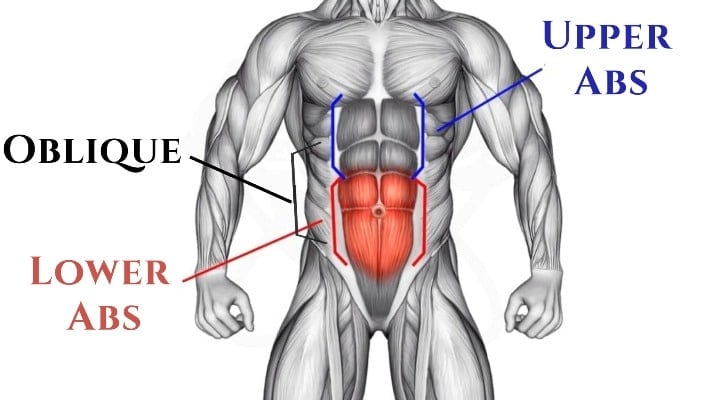
Know More Body Fat %: Use Our Free Body Fat Calculator
How To Work Upper Abs
When trying to target the upper abs, it’s important to keep in mind that there is no true isolation exercise for any of the abdominal muscles. This muscle group works best when it works together.
While some exercises may hit the upper abs more than the other core muscles, all the core muscles will be working together throughout the movement.
Your abs act on spinal flexion and hip flexion. When discussing exercises specifically for the rectus abdominis, it will be one of these actions.
For your upper ab, they will be the most activated during movements that bring your upper body toward your hips/legs (spinal flexion). Means bringing your chest closer to your pelvis.
For example, the following exercises will target your upper abs:
- Sit-ups
- Crunches
You can do a variety of upper ab exercises to help you build a strong core. There are many exercises that are good for beginners and advanced learners.
Additionally, there are upper abs exercises that don’t require equipment for people who train at home or aren’t ready to lead the movement.
15 Best Exercises For The Upper Ab
Here are 15 excellent upper abs exercises and workouts to build an impressive six-pack.
Luckily, there are many exercises you can try at home without any special equipment, such as crunches, sit-ups, planks, and v-ups.
- Sit-Ups
- Crunches
- Bicycle Crunch
- Cable Crunch
- Twisting Sit-Up
- Machine Crunch
- Decline Crunch
- V-Up
- Vertical Leg Crunch
- Abs wheel rollout
- Stability Ball Forearm Plank
- Elbow To Knee Side Plank Crunch
- Hollow Hold
- Inchworm
- Plank To Toe Touch
1. Sit-Ups
Sit Up is an excellent choice for creating muscular tension in your upper abs and help to strengthen your abs transverse abdominis, and obliques in addition to your hip flexors, chest, and neck.
They promote good posture by working your lower back and gluteal muscles.
The sit-up is a classic best upper abs exercise that you can do at home. They use your body weight to strengthen and tone the core-stabilizing abdominal muscles.
- Level: Beginner
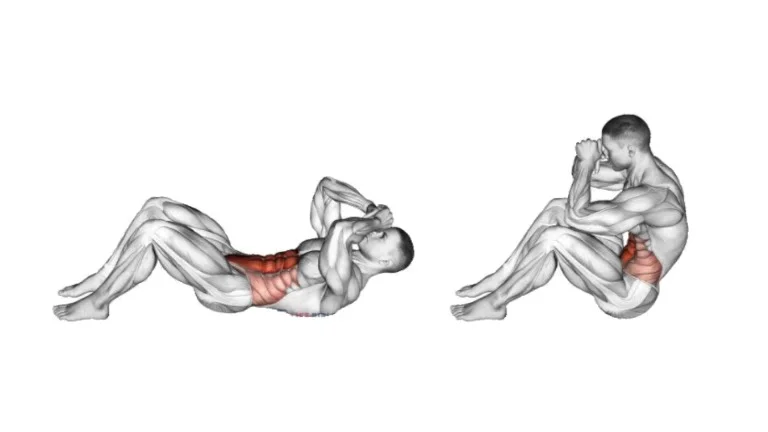
How To Do It
- Hook your feet under the pad and sit on the decline bench with your torso upright.
- Place your hands behind your head, contract through your abs to lift your shoulders and upper back off the decline bench.
- Hold this position for a second before slowly lowering back to the starting position, making the negative portion of the rep as slow and deliberate as the positive portion.
- Repeat the desired number of reps.
Tips
- Don’t lean forward with your head. Keep a natural head position.
- Don’t let your shoulders roll forward. Keep your chest up and shoulders back.
2. Crunch
Crunches are another great exercise for your upper abs workout. The crunch motion occurs in the upper spine, and your shoulders rise a few inches off the floor.
Your lower back remains in contact with the floor, and there is no motion at the hips. This is in contrast to the sit-up, where the movement occurs at the waist and hips.
You may position your hands at your sides or across your chest, or you may interlock them behind your head.
- Level: Beginner

How To Do It
- Lie on the floor with your knees bent, feet and low back are flat on the floor.
- Place your hands behind your head, contract through your abs to lift your shoulders and upper back off the floor.
- Hold this position for a second before slowly lowering back to the starting position, making the negative portion of the rep as slow and deliberate as the positive portion.
- Repeat the desired number of reps.
Tips
- Keep the movement slow and controlled. Don’t use momentum.
- Don’t pull on your neck with your hands, this will strain the neck.
- Breathe out as you crunch, maintain your core muscles tight and engaged.
Know More: Best Abs Exercises: Upper Abs, Lower Abs, Obliques
3. Bicycle Crunch
In a 2001 study by ACE, it was found that in compared to the standard crunch, the bicycle crunch produces 148% more mean activity in the abs and 190% more mean activity in the obliques.
To make it easier, you can kneel with a smaller angle, and to make it harder, you can kneel with a larger angle.
- Level: Beginner and Intermediate
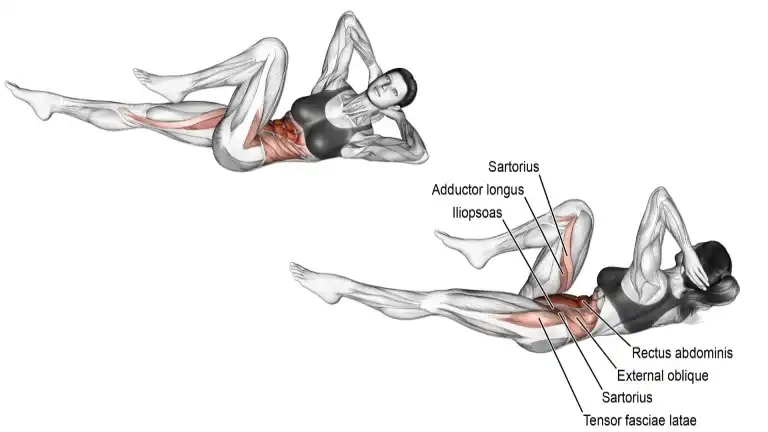
How To Do It
- Lie on the floor with your legs straight and low back are flat on the floor.
- Place your hands behind your head and raise your feet and upper back a little off the floor.
- Slowly start raising your knees about a 45-degree angle.
- Go through a bicycle pedaling motion with your legs as you alternately touch your elbows to the opposite knees, twisting back and forth.
Tips
- Keep your neck aligned with your spine and your lower back pressed against the floor.
- Make sure you’re not pulling your neck with your hands, or you could get a neck strain.
4. Cable Crunch
Cable crunches are a weighted crunch variation that targets your upper abs muscles. Doing crunches on a cable apparatus offers one huge advantage over doing them on the floor.
The cable allows you to increase resistance, enabling you to train to failure using heavier weights and fewer reps. This increased emphasis on strength and hypertrophy is exactly what the fast-twitch muscle fibers in your abs need to get big and carved.
- Level: Intermediate and Advance
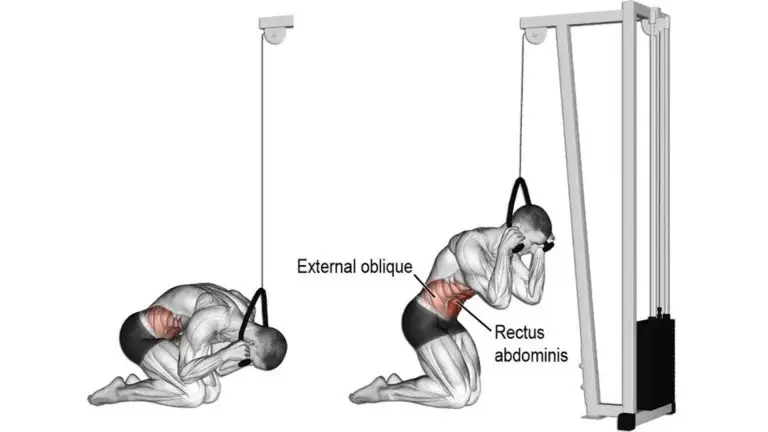
How To Do It
- Kneel in front of a high pulley. Take hold of the rope attachments with each hand and place your wrists against the sides of your head.
- Lower your torso by flexing your hips, but allow the weight of the rope to lift your upper torso so that your lower back is extended.
- Keeping your hips fixed, exhale as you pull the rope downward by flexing your abdomen so that your back becomes arched.
- Hold for a count of two. Relax your abdomen and allow the rope to lift your upper torso so that your lower back goes back to being extended.
Tips
- Keep your hips fixed. All of the movement should be in your abdomen.
- Don’t choose a weight so heavy that your lower back handles most of the resistance.
Know More: Most Effective Abs & Oblique Cable Exercises & Workout
5. Twisting Sit-Up
A decline sit-up bench positions your upper body at an angle so that it’s lower than your hips and thighs. It is a challenging exercise for developing the upper abs.
This position causes your body to work harder, since you have to work against gravity and through a wider range of motion.
It’s a great exercise for intermediate to advanced lifters because it is moderately challenging but very effective for its intended purpose.
- Level: Intermediate and Advance
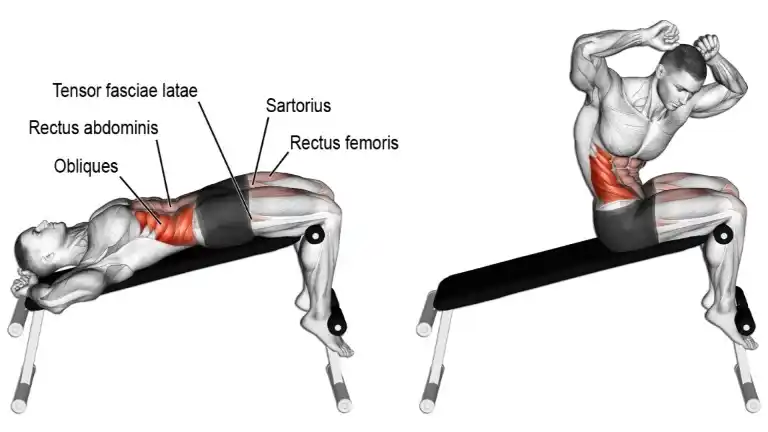
How To Do It
- Sit on the decline bench, hook your feet under the pad, lean back, and position your hands behind your head.
- As you sit up, twist your torso, directing your right elbow toward your left knee.
- Reverse the motion and lower your torso to the starting position; during the next repetition, direct your left elbow toward your right knee.
- Keep repeating and alternating the side to which you twist your waist.
Tips
- Keep your neck in a neutral position.
- Use a slow, controlled motion to target the muscles.
6. Machine Crunch
Abs crunch exercises with an ab crunch machine are a great way to strengthen your abdominal muscles and obliques.
It is certain that adding this movement to your workout regime will help you on your path to getting great abs.
This is a convenient way to add resistance to your ab work for better abs development.
Your torso should move from the upright position to almost parallel with the floor. When you sit on an ab crunch machine, you stand a chance at going through a full range of motion.
- Level: Intermediate and Advance
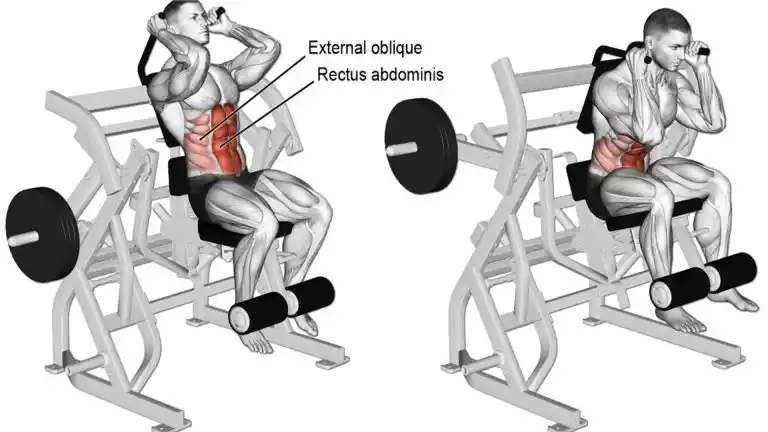
How To Do It
- Sit on the ab machine and select a slight resistance.
- Position your feet under the pads and hold the handles at the top.
- Make sure your arms are bent at 90 degrees.
- Keep your feet stationary and perform crunches as instructed in the machine directions, focusing on the contraction of your abs.
- Pause and slowly return to the starting position as you inhale.
Tips
- Keep your motions slow and steady to reduce the risk of injury.
- I would recommend starting with weights that you are familiar with and gradually increasing them.
7. Decline Crunch
The decline crunch is similar to the basic floor crunch, except with a greater range of motion. It is one of the most effective abs exercises that creates good tension in your upper abs during crunch.
It is a relatively simple exercise that will not only improve your core, but also help you get closer to having a six-pack ab.
- Level: Intermediate and Advance
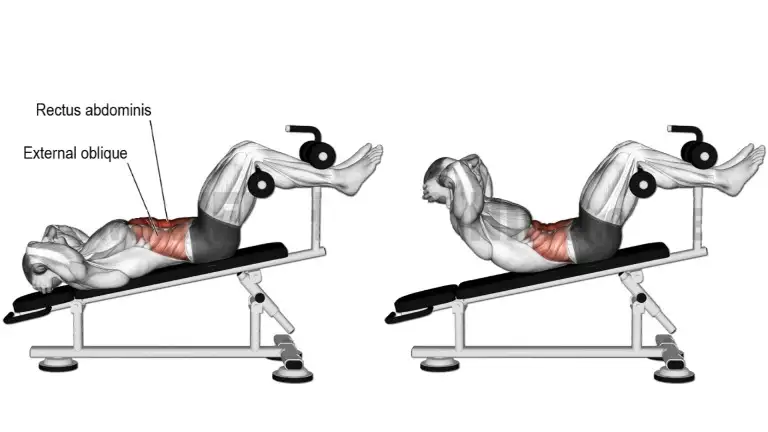
How To Do It
- Lie back in a decline bench with your feet secured under the foot pad.
- Place your hands behind your head, or place them by your ears.
- Curl up as high as you can to bring your shoulders and upper back off the bench, simultaneously pressing your lower back into the bench.
- Hold this position for a second before slowly lowering back to the starting position.
Tips
- Don’t allow any momentum to build up, keep the movement slow and under control.
- When at the top of your movement, contract the abs for a few seconds.
8. Best Exercises for the Upper Abs V-Up
The V-Up also known as a jackknife is a full-body move that works your core, legs, back, and shoulders. The exercise works the upper and lower abs muscles simultaneously.
A V-Up involves sitting on the floor or a mat and positioning the body in the shape of the letter “V. This helps you to build up core strength and upper ab muscle mass.
It requires you to lift the weight of both your arms and legs by using your abdominal muscles.
- Level: Intermediate and Advance
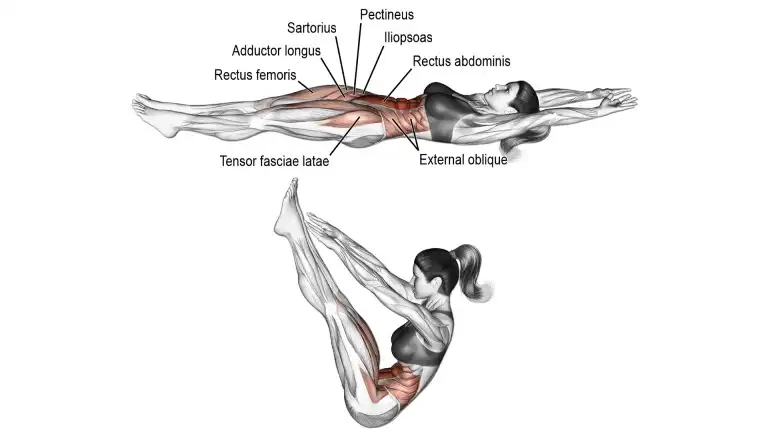
How To Do It
- Lie down on the floor on your back with your arms extended straight back behind your head. Your legs should also be extended.
- Exhale and bend at your waist while raising your legs and arms to meet in a jackknife movement. Try to hold the contracted position.
- Lower your arms and legs back to the starting position, inhaling as you do so.
- Repeat for the desired number of reps.
Tips
- The movement should be kept slow and controlled.
- Try to keep your back as straight as you can during the V-sit up.
9. Vertical Leg Crunch
If you are looking for another effective upper abs exercise, you should try the Vertical Leg Crunch. It is similar to the basic crunch, except that the legs are perpendicular to the floor.
This position increases the intensity of the exercise, so it is a good next step after you’ve mastered the basic crunch.
- Level: Intermediate and Advance
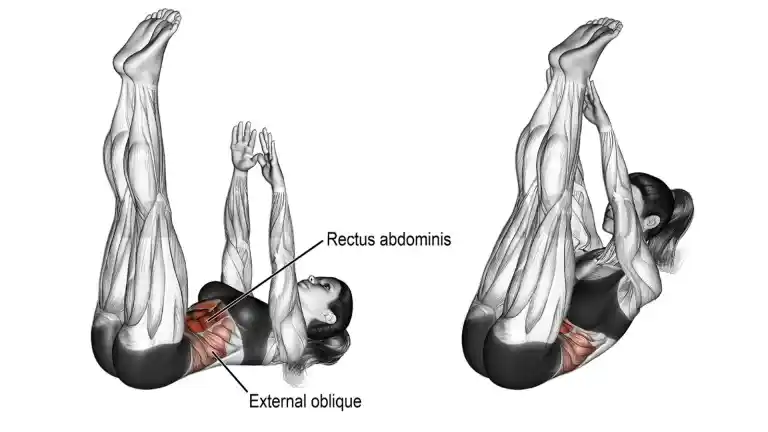
How To Do It
- Lie down on the floor on your back with your arms extended straight back behind your head.
- Your legs should also be extended.
- Raise your arms and legs straight up into the air.
- Extend your arms and reach toward your toes when you perform the crunch.
- Hold the contracted position for a count of two, slowly return to the starting position.
- Repeat for the desired number of repetitions.
Tips
- Don’t round your neck and spine.
- Reach as far as you can without rounding your shoulders and upper back.
Read More To Know More: Best Dumbbell Abs Workout To Build Six Pack Abs
10. Abs wheel rollout
If you’re looking for a way to get more creative with your upper abs workout, why not try Abs wheel rollout.
It strengthens the upper ab by lengthening them, which targets your eccentric strength. It is one of the more advanced exercises.
To build yourself up to it, you can start with the plank and graduate to the wheel rollout when ready. You can also make the exercise easier by performing it up an inclined surface.
They’re also an excellent conditioning exercise for athletes. This ab wheel workout can be used at home or in gyms.
- Level: Intermediate and Advance
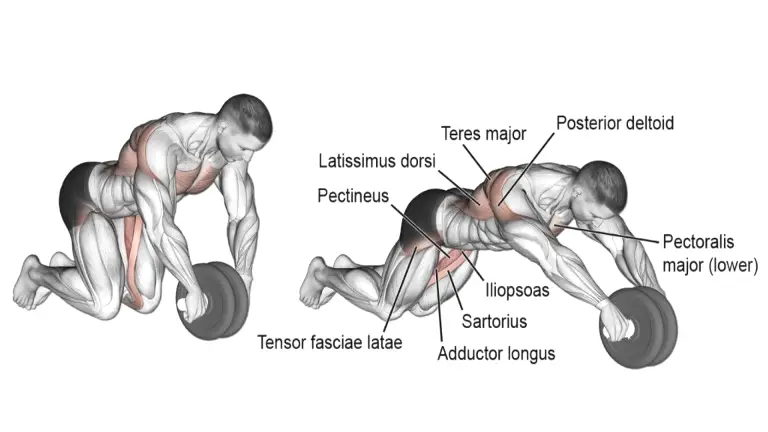
How To Do It
- Kneel on the floor and grasp the ab wheel roller with your hands, your arms should be straight and your torso fairly upright in the start position.
- Allow the abs wheel to roll forward as far as possible with just your knees and toes touching the floor while you maintain your grip on this.
- The goal is to be as flat as possible in the finish position, with your torso and upper legs parallel with the floor and hovering just a couple of inches above it.
- Then reverse the motion to pull the abs wheel back toward your knees until your body is upright again.
- Do as many reps as you can.
Tips
- Squeeze your abs and glutes throughout the movement for stability.
- Move within a comfortable range of motion. You should not strain your lower back.
- Do not allow your hips to sag at any point during the movement.
11. Stability Ball Forearm Plank
Stability Ball Forearm Plank is a challenging and effective core body exercise that forces you to pull your abs in, tighten your glutes and squeeze your legs to hold your body in a straight line.
This is an advanced move that will challenge you far beyond standard plank.
- Level: Intermediate To Advanced
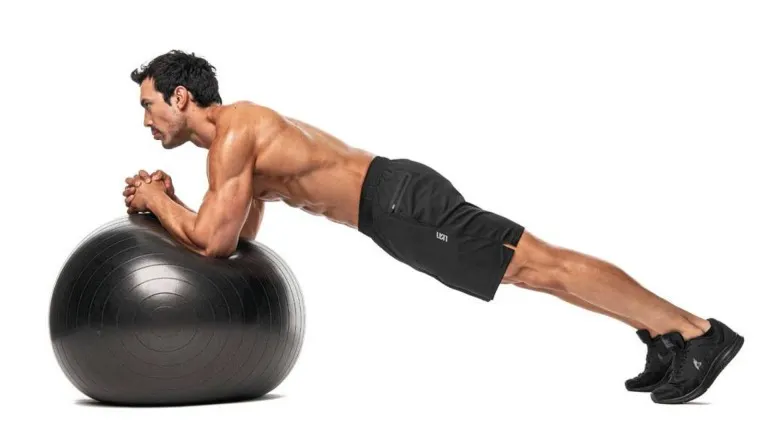
How To Do it
- Get into a straight body position from your head to your heels.
- Place your forearms on the stability ball and feet on the floor; maintain a straight body position from your head to your heels.
- Stack your shoulders directly over your elbows, and press your forearms into the stability ball to support your shoulders.
- Maintain a tight core while squeezing through your quads and chest.
- Hold this position for a set amount of time.
Know More: Plank Exercise: Benefits, Variations, Muscles Worked, Tips
12. Elbow To Knee Side Plank Crunch
The Elbow To Knee Side Plank Crunch is a brilliant bodyweight exercise that helps you to develop the strength and stability of your upper abs and oblique.
Combine your standard crunches with side plank exercise into one move that will challenge your balance, tone up your waist, and strengthen your core.
- Level: Intermediate and Advance
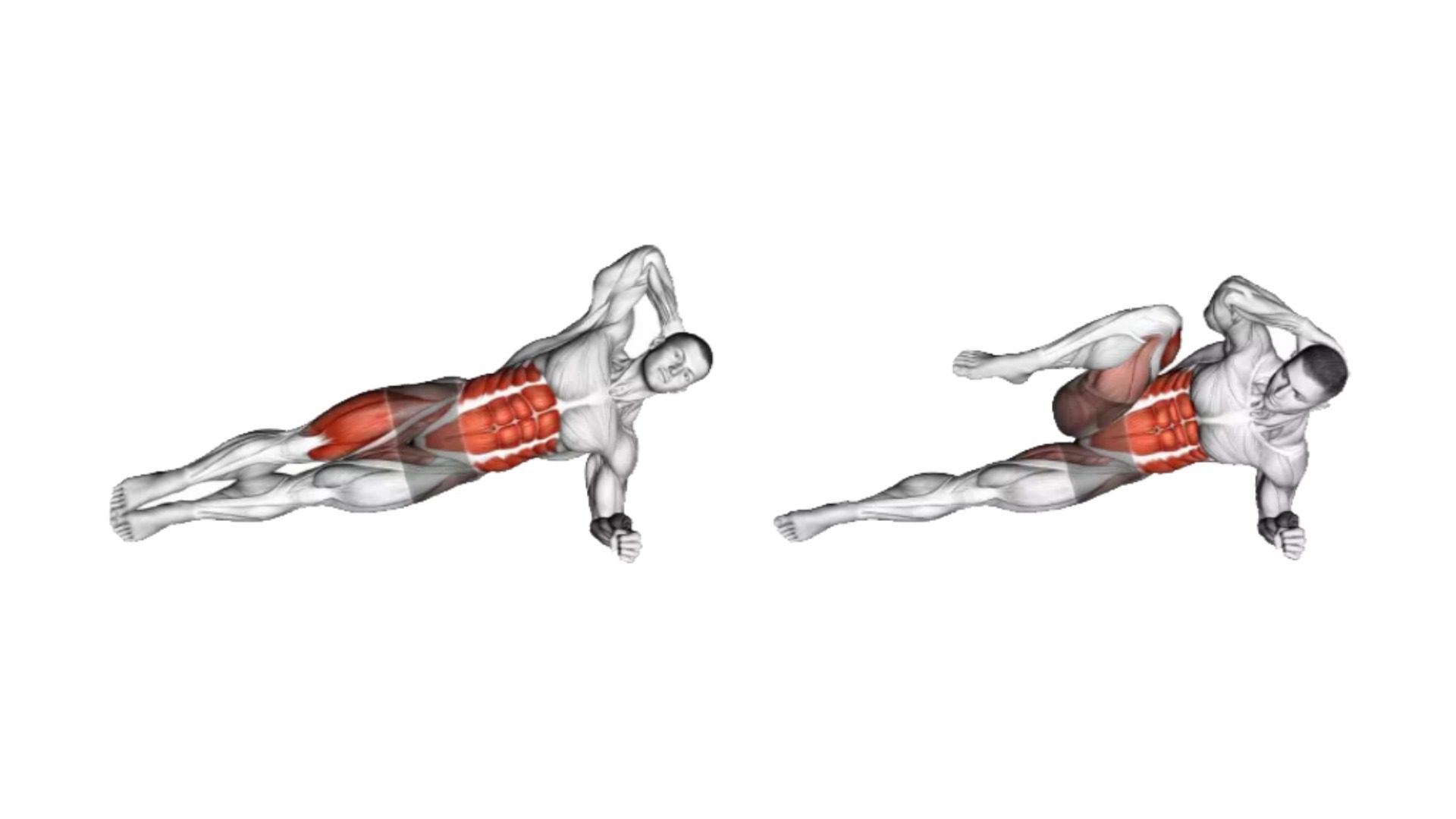
How To Do It
- Get in a side plank position by lying on your right side on the floor with your left foot rested on top of the inner side of your right foot and your left arm rested on top of your left side.
- Raise your body by placing your right forearm flat on the floor so that it’s perpendicular to your torso.
- Lift your torso until your right upper arm is straight underneath you, with your elbow bent 90 degrees and your forearm flat on the floor. Extend your left arm over your head.
- Lift your left leg and drive your knee toward your torso.
- At the same time, bring your left arm in toward your knee in a crunch movement.
- Continue for a set amount of time, and then repeat on the other side.
13. Hollow Hold
The hollow holds are like upside-down planks. You position yourself on your buttocks, with your legs and arms extended, in order to increase your center of mass.
Your upper abs are at your center, and they will be working hard to keep you upright. Aside from being a highly effective exercise, this move requires very little space and no equipment.
- Level: Beginner and Intermediate
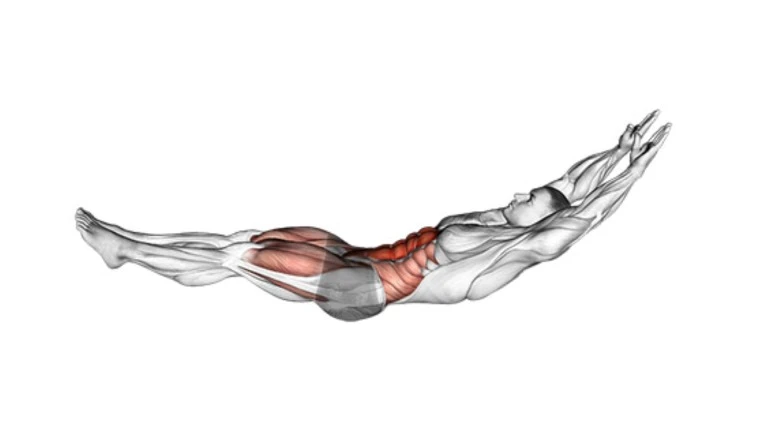
How To Do It
- Lie down on your back and extend your arms above your head so that your biceps are next to your ears.
- Brace your core by drawing your ribs toward your pelvis and flexing your abs.
- Lift your feet, legs, shoulders, and arms off of the floor and press your lower back into the ground.
- The only place you should touch the floor is your lumbar spine.
- Hold the pose for a few seconds, working up to longer holds as you get stronger.
14. Inchworm
inchworms are a great upper ab exercise for beginners and don’t require any equipment.
This full-body movement is an effective exercise to include in a warm-up routine or as a part of a training circuit.
- Level: Beginner and Intermediate
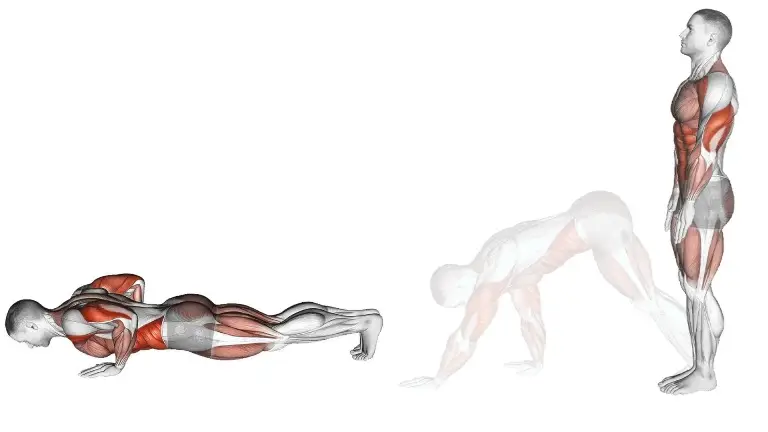
How To Do It
- Position yourself at the back of the mat with your feet hip-width apart and your arms by your sides.
- Slowly bend over until both hands touch the floor in front of the feet.
- Keeping legs as straight as possible and core tight, walk hands forward into a plank position.
- Hold for a moment, then slowly reverse the movement to return to start. That’s one rep.
- Complete as many reps as possible in 20-30 seconds.
15. Plank To Toe Touch
The plank to toe touch is a variation of the traditional plank exercise that adds an extra level of difficulty and engagement for your core and upper ab muscles.
This is a great move to add to your warmup on upper body days since it helps increase blood flow, warms the body, activates the core, mobilizes the shoulders, and stretches the hamstrings.
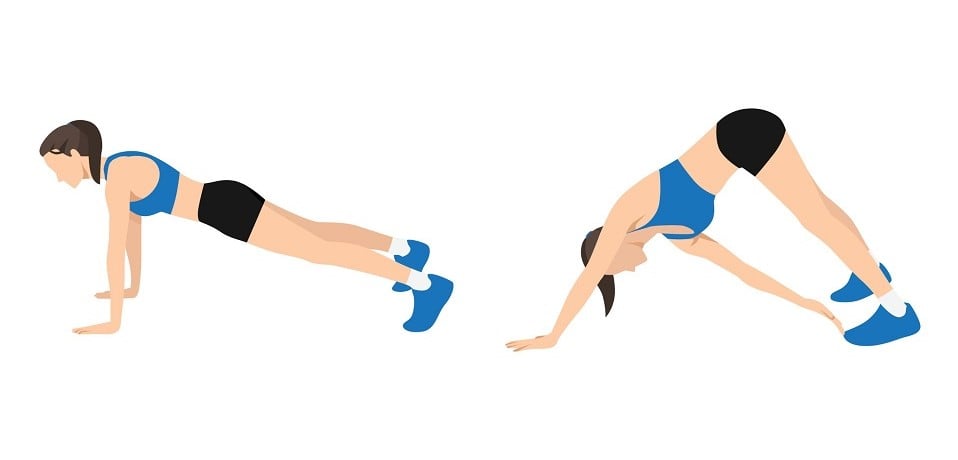
How To Do It
- Start in a high plank position
- Push your hips up high
- Keep your legs straight
- Take your right hand and reach for your left toe
- Return to the high plank position
- Take your left hand and reach for your right toe
- Complete 3-4 sets of 10-15 reps on each side
Tips for Upper Ab Training
Below, I have listed sample workouts for beginner, intermediate, and advanced levels. I’ve also provided the number of sets and reps you should aim for. It is important, however, that you not approach these exercises with speed in mind. Keep your focus on form and motion, and do it slowly and controlled.
Upper Ab Workout Routine
If your upper abs are lagging, and you really want to build an impressive six-pack abs, you can prioritize it, but still don’t forget about your lower abs and oblique muscles.
Beginner level Upper Ab Workout
If you’re new to lifting weights, don’t worry. This beginner-friendly abs workout routine is a great place to start.
| Exercise | Sets | Reps |
|---|---|---|
| Sit-Ups | 4 | 8-10 |
| Crunches: | 4 | 12-15 |
| Bicycle Crunch: | 3 | 8-12 |
Intermediate Upper Abs Workout Plan
If you are an intermediate level or have outgrown the beginner routine, try the intermediate abs workout routine below.
| Exercise | Sets | Reps |
|---|---|---|
| V-Up | 4 | 10-12 |
| Bicycle Crunch | 4 | 8-10 |
| Seated Knee Up | 3 | 8-12 |
| Decline Crunch | 3 | 8-10 |
Advanced Upper Ab Workout
If you are an advanced level athlete or have already completed the beginner and intermediate abs workouts, give the advanced routine a try.
Here, you’ll challenge more of your balance, stability, and strength.
| Exercise | Sets | Reps |
|---|---|---|
| Cable Crunch | 3-4 | 8-10 |
| Twisting Sit-Up | 3-4 | 8-12 |
| Vertical Leg Crunch | 3 | 10-12 |
| Abs Wheel Rollout | 3 | 8-10 |
You don’t exercise every other body part every day, so don’t do it for your rectus abdominis either.
It is especially the case with an intense exercise routine, where your muscles need some time to recover.
FAQs On Best Exercises for the Upper Abs
What is the best exercise for upper abs?
Here are the best upper abs exercises to build impressive six-pack abs and stronger core.
- Sit-Ups
- Crunches
- Bicycle Crunch
- Seated Knee Up
- Cable Crunch
- Twisting Sit-Up
- V-Up
- Vertical Leg Crunch
- Abs Wheel Rollout
Do planks work upper abs?
Yes, a plank is an excellent exercise for developing a strong core, including your upper and lower abs,
Can you target upper abs?
When attempting to target the upper abs, it is important to keep in mind that there is no true isolation exercise for any of the abdominal muscles. However, if you are interested in targeting your upper abs specifically, you can do that by focusing on movements that involve pulling your chest toward your pelvis.
Do planks work upper or lower abs?
Planks target the whole abs, including the upper and lower abs. Additionally, planks don’t just work your core, they work your entire body. Plank is one of the brilliant bodyweight abs exercises that you can add to your home workout regime. It helps you to develop the strength and stability of your core.
Do crunches work upper abs?
The crunches and sit-ups are both best exercises that work the upper abs. They provide intense muscle isolation, which makes them a popular exercise for people trying to get six-pack abs.
How Often Should You Train the Upper Abs?
Most beginners will notice improvement in their abdominal muscles after training them directly two to three days per week. Since many strength movements involve the core and upper abdominal muscles.
How to get rid of upper belly fat?
A diet is the most important thing for getting rid of upper belly fat. Cardio and exercises alone won’t be enough to burn fat.
How can I build my upper abs at home?
To build a solid core and chiseled upper abs at home without any special equipment, you must add crunches, sit-ups, planks, and v-ups to your abs workout regime. With such a variety, it’s easy to develop a great upper ab routine to go through a few times a week.
Conclusion
If you want to build your abs and get stronger, you should do these abs exercises. It not only targets the upper abs, but also strengthens the entire abdominal area.
It is easy to do and requires no more scientific details. If you keep doing this, the results will speak for themselves.
Thanks for reading, enjoy for workout!
References
- Phys Ther. 2000 Jun;80(6):564-9. Abdominal muscle response during curl-ups on both stable and labile surfaces. Vera-Garcia FJ1, Grenier SG, McGill SM.
- Tremblay A, Simoneau J-A, Bouchard C. Impact of exercise intensity on body fatness and skeletal muscle metabolism. Metabolism. 1994;43(7):814–818
15 Best Exercises For Upper To Build Stronger Core

Manish brings over 10 years of hands-on experience in weight lifting and fat loss to fitness coaching. He specializes in gym-based training and has a lot of knowledge about exercise, lifting technique, biomechanics, and more.
Through “Fit Life Regime,” he generously shares the insights he’s gained over a decade in the field. His goal is to equip others with the knowledge to start their own fitness journey.
